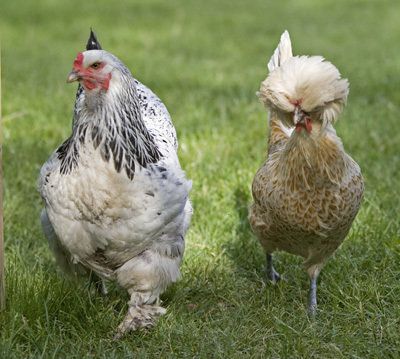
Without getting into the gory details, industrially produced chickens lead a (how do I say this nicely?) less than charmed life. This point was driven home for me reading Nicolette Hahn Niman's new book Righteous Porkchop, which spends a good chunk of the book discussing the roots of all industrial livestock production -- poultry processing. Mass-produced chickens are treated horribly and fed a diet of drug-laden feed -- it ain't pretty. Below I outline your various options for how/where to get chicken you can feel good about.
Best case scenario: You are raising some chickens in your back yard. What better way to make sure these guys are living a happy healthy life? Heck, if you live in NYC you can even join Just Food's City Chicken Meet-up for NYC chicken enthusiasts!
Next best: Buy direct. You live near a farmer who is raising chickens. You buy straight off the farm.
This is nice, too: You belong to a poultry CSA. By now you've probably heard of Community Supported Agriculture, where you buy a share in a farm, and get a weekly box of produce all growing season long. Well fruits and veggies are the only items being sold this way -- many farmers are starting to offer eggs, poultry, meat, even bread. Also in this category: buying from a poultry farmer at the farmers market.
The limited options scenario: What you have to shop at is a regular old grocery store. A bunch of name brand chickens, as far as the eye can see. But stop: are those some Murray's chickens over on the side? Murray's chickens are available in many major grocery chains and have a bunch of good things going for them. They are certified humane. They have minimal packaging. They are drug free. And, they are "traceable." This means that you can go to their website and find out exactly which farm your particular chicken comes from. The info on the farms is kind of generic, and definitely seems to play off of all of our "agrarian-pastoral"* fantasies, but....not bad.
Worst case scenario: Nothing but industrially raised chickens, as far as the eye can see. You're not going to like this, but I will encourage you to go chicken-less while you figure out some new options (see "Best case scenario").
Now, as you move forward in the kitchen with this new chicken of yours, here's an idea: stop buying your chickens all cut up in parts. What, you don't know how to use a knife? If you buy a whole chicken you can:
a) roast it in the oven (I recommend The Barefoot Contessa's "Perfect Roast Chicken.") Eat all the parts that you like to eat and that are easy to get at. Save the livers for country style pate (River Cottage Cookbook anyone?).
b) pull off some more meat for chicken salad. Mix the shredded meat with a little mayo, a little Dijon mustard, salt pepper, lemon juice, minced red onion, and a little dried tarragon
c) make stock: put the bones in a pot with some carrots, celery, onions, leeks, whole peppercorns, and water. Boil it until lots of water evaporates. Then maybe add some more water and boil it some more, until it reduces down to a thick, rich chicken-y broth.
That's one (free-range, antibiotic free) chicken, 3 meals, not a lotta waste.
* courtesy Michael Pollan